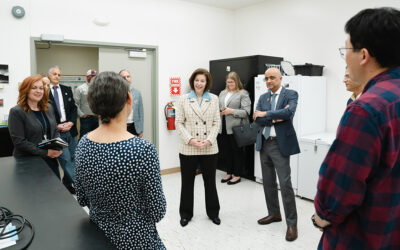An international team of scientists have assembled the first complete record of carbon monoxide concentrations in the southern hemisphere, based on measurements of air.
An international team of scientists has reconstructed a historic record of the atmospheric trace gas carbon monoxide by measuring air in polar ice and air collected at an Antarctic research station.
The team, led by the French National Centre for Scientific Research (CNRS) and Australia’s national science agency, CSIRO, assembled the first complete record of carbon monoxide concentrations in the southern hemisphere, based on measurements of air.
The record spans the last three millennia.
DRI scientists Nathan Chellman, Ph.D., and Joe McConnell, Ph.D, co-authored the study, which was published November 15 in the journal Climate of the Past.
“Fires are important sources of atmospheric gases such as carbon monoxide, as well as tiny particles called aerosols, both of which contribute to global climate change,” McConnell says. “Documenting how fire emissions have changed in the past is critical for accurate climate modeling, and measurements in polar ice cores – including those reported here – provide the most reliable records of past fire emissions. Such measurements are challenging, however, so the DRI ice core group has been working for more than a decade with colleagues from around the world to develop and apply new methods for measuring carbon monoxide and related gases that are more accurate, efficient, and reliable.”
CSIRO atmospheric scientist David Etheridge, Ph.D., said that the record provides a rare positive story in the context of climate change.
“Atmospheric carbon monoxide started climbing from its natural background level around the time of the industrial revolution, accelerating in the mid-1900s and peaking in the early-mid 1980s,” Etheridge said.
“The good news is that levels of the trace gas are now stable or even trending down and have been since the late 1980s – coinciding with the introduction of catalytic converters in cars.”
Carbon monoxide is a reactive gas that has important indirect effects on global warming. It reacts with hydroxyl (OH) radicals in the atmosphere, reducing their abundance. Hydroxyl acts as a natural ‘detergent’ for the removal of other gases contributing to climate change, including methane. Carbon monoxide also influences the levels of ozone in the lower atmosphere. Ozone is a greenhouse gas.
The authors have high confidence that a major cause of the late 1980s-decline was improved combustion technologies including the introduction of catalytic converters, an exhaust systems device used in vehicles.
“The stabilisation of carbon monoxide concentrations since the 1980s is a fantastic example of the role that science and technology can play in helping us understand a problem and help address it,” Etheridge said.
The response from the global community to the identification of carbon monoxide as an air pollutant and indirect greenhouse gas in the 1980s was rapid. Catalytic converters have been mandatory in all new cars since 1986 in Australia, and in the rest of the world, as early as the 1970s. Catalytic converters remove carbon monoxide, a harmful gas to humans and the environment.
Etheridge said the reduction in CO emissions reduced their contribution to local air pollution. It also had the effect of mitigating the growth of CO concentrations in the global atmosphere, leading to a climate benefit. Methane is an extremely potent greenhouse gas, which has even higher global warming potential than carbon dioxide, at least 28 times, due to its efficiency in trapping heat.
“Decreased levels of carbon monoxide take the pressure off hydroxyl, meaning it can scrub out gases like methane instead, so it indirectly mitigates methane and its impact on climate,” Etheridge said.
Etheridge said the results demonstrate how scientific and technological interventions can aid policies to address pressing global challenges like climate change.
Global policies would be further needed with concentrations of greenhouse gases like carbon dioxide, methane and nitrous oxide continuing to rise.
“We know that science and technology can help to identify key global problems and help decision-makers understand what’s required to reduce emissions,” Etheridge said.
The research was a result of a long-term international collaboration with CNRS in France, and with multiple international and Australian organisations, including the Australian Antarctic Division. Sharing historic data across multiple institutes and organisations, including of ice cores, air samples and trapped air bubbles in snow, known as firn, made it possible to build a complete picture of carbon monoxide over millennia.
The earliest ice sample collection in Antarctica for the project was in 1993, following the 1991 French-Australian Antarctic Treaty on protection of the Antarctic environment.
“Because carbon monoxide is a reactive gas, it is difficult to measure long term trends because it is unstable in many air sample containers. Cold and clean polar ice however preserves carbon monoxide concentrations for millennia,” Etheridge said.
The CO data will be used to improve Earth systems models. This will primarily enable scientists to understand the effects that future emissions of CO and other gases (such as hydrogen) will have on pollution levels and climate as the global energy mix changes into the future.
###
*Issued by Australia’s National Science Agency, CSIRO: https://www.csiro.au/en/news/All/News/2023/November/3000-years-of-carbon-monoxide-records-show-positive-impact-of-global-intervention
More information: The full study, Southern Hemisphere atmospheric history of carbon monoxide over the late Holocene reconstructed from multiple Antarctic ice archives, is available from the journal Climate of the Past: https://cp.copernicus.org/articles/19/2287/2023/


